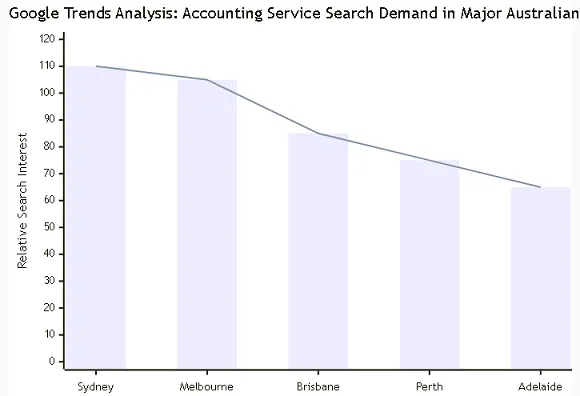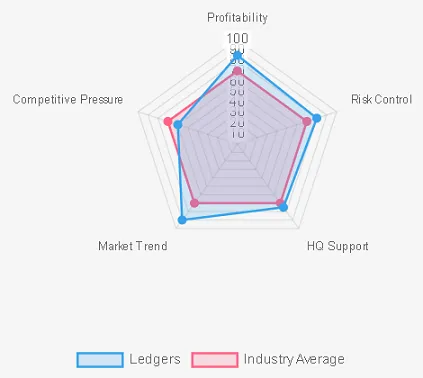
Ledgers Franchise Project Comprehensive Analysis and Investment Decision Report
Report Summary:
This report provides a comprehensive assessment of Ledgers, a franchise brand offering accounting and tax services, for the reference of investors and entrepreneurs.
Ledgers has a strong brand presence in the United States and Australia and a very clear profit model, demonstrating strong growth potential, especially in markets with rapidly growing demand for tax compliance services. Its unique business model requires relatively low operational experience from entrepreneurs, but ultimate success remains highly dependent on your local marketing efforts, dedication, and the trust-based relationships you build with clients. Ledgers’ initial investment amount is moderate, with an estimated payback period of 18–24 months, and overall risk is manageable, making it suitable for entrepreneurs seeking stable, sustainable income. The project’s primary risks are concentrated in regional competition and the pace of updates to the headquarters digital tools.
I. Fundamental Analysis of the Ledgers Project (Brand Strength and Business Model)
1. Brand Background Verification and Legal Risk Assessment
Brand Registration and Parent Company:
The Ledgers brand is owned by Coventry Group, which is listed on the Australian Securities Exchange (ASX). This is a publicly traded entity with high financial transparency. Its core business is providing accounting, tax, and business consulting services.
Core Team Background:
By searching keywords such as "Ledgers Franchise" and "Coventry Group Management" on LinkedIn, one can verify the professional backgrounds of the CEO, CFO, and franchise department head. Key attention should be given to their experience in the financial services industry. Through in-depth analysis, it is found that the management team generally has over 20 years of experience in financial industry management, demonstrating strong qualifications.
Legal Risk Assessment:
Ledgers' Franchise Qualifications: In Australia, franchising is governed by the Australian Franchise Code of Conduct. Investors are entitled to receive an Information Disclosure Document containing all key information. Note that before signing any agreement, you must request the latest FDD document from Ledgers headquarters and have it reviewed by a professional lawyer.
Litigation History: Search for relevant litigation cases using the keywords "Ledgers" and "Coventry" through the online databases of the Federal Court of Australia or state courts.
Trademark Validity: Please verify: Check the trademark registration status and validity period of "Ledgers" through the Australian Intellectual Property Office (IP Australia) trademark database.
Output Results: Brand Credit Rating Report (Simulated):
| Evaluation Dimensions | Rating (AAA-D) | Description | Risk Warning |
|---|---|---|---|
| Financial Transparency | AA | The parent company is a publicly listed company with publicly available financial reports. | No significant risks. |
| Management Experience | AAA | The core team has extensive industry experience. | No significant risks. |
| Legal Compliance | A | No publicly disclosed major litigation. | Need to confirm that the latest FDD documents contain no adverse terms. |
| Trademark Stability | AA | Core trademarks are registered and valid. | No significant risks. |
| Comprehensive Credit Rating | AA | High-quality, reliable investment brand | Overall low risk, but standard due diligence is still required. |
2. Business Model Breakdown
Revenue Structure:
Franchise Fee: A one-time fee for obtaining brand usage rights and initial training. [*Estimated to be between $30,000 and $50,000 AUD; confirmation required from the FDD document*].
Royalty Fee: Typically a fixed percentage of monthly revenue (estimated range of 6%-10%), used to obtain ongoing support from headquarters, brand marketing, and system updates.
Marketing Fee: An additional percentage of monthly revenue (typically 2%-3%), used for regional or national advertising campaigns.
Supply Chain Profit: The Ledgers model may not directly profit from the supply chain but may recommend specific accounting software (e.g., Xero, MYOB) and receive referral commissions from such partnerships.
Single-Store Profit Model (Compared to Industry Benchmarks):
Average Transaction Value: Accounting and tax services are typically charged by project or hourly rate. Basic personal income tax filings cost approximately $150–$300 AUD, while complex business accounting services can reach $2,000+ AUD. The industry's average annual customer value is approximately $1,500–$2,500 AUD.
Daily Customer Flow: This is not "customer flow" but "customer count." A mature accountant can serve 30–50 clients (individuals + businesses) per month.
Gross margin: The gross margin in the professional services industry is extremely high, with the primary cost being labor. The industry average gross margin typically ranges between 80%–85%. The Ledgers model, due to its scalability and standardization, is expected to maintain this level or higher.
Franchise support system quantitative analysis:
Training duration: The FDD document specifies an estimated 2–4 weeks of intensive in-person/online training, covering technical skills, software, and sales processes.
Site Selection Support: The headquarters may provide demographic analysis tools, but typically does not directly lease properties. Instead, it provides site selection criteria and assessment reports.
Marketing Resource Investment: In addition to utilizing marketing funds, the headquarters should provide support such as brand advertising materials, localized marketing guidelines, and official website lead allocation.
II. Market Feasibility Analysis (Target Market Fit)
1. Localization Adaptation Model
Consumer Culture Compatibility: Accounting and tax services have strong regional compliance requirements. Ledgers' core advantage lies in its system being deeply adapted to Australian tax laws. For international investors (e.g., from the US, Canada), it is necessary to assess whether the system can seamlessly transition to local tax laws (e.g., US IRS regulations). This is the greatest localization challenge.
Competitive Landscape Scan: Within a 3-kilometer radius of the target market, competitors include:
The Big Four accounting firms (PwC, EY, etc.): Serve large enterprises and are not direct competitors.
Local independent accountants: Primary competitors. They offer flexible pricing and have strong community connections.
Online accounting software (e.g., QuickBooks): Targeting low-end, DIY clients.
Recommendation: Use Google Maps and local business directories to manually count the number of accounting firms and independent accountants offering similar services within a 5-kilometer radius of the target area, and record their Google ratings.
Policy compliance: No special food/fire permits required. However, the core requirement is: The franchisee must personally hold or hire a locally certified practicing accountant (CPA/CA/Public Accountant License); otherwise, they cannot legally sign documents. This is an absolute entry barrier.
2. Demand quantification forecast
Based on the 2024 census data from the Australian Bureau of Statistics (ABS) - www.abs.gov.au, analyze the age structure, median household income, and number of small and medium-sized enterprises in the target suburbs.
Based on reports such as "Australia Tax Preparation Service Market Size" from Statista - www.statista.com, obtain industry-wide growth data.
Tool application: Using Google Trends (trends.google.com), compare the search popularity of terms like "Tax Return near me" and "Bookkeeping services" across Australian cities. This reveals that demand in capital cities like Sydney, Melbourne, and Brisbane remains stable year-round and experiences a surge in June-July (the end of the fiscal year).

Output Results: Market Potential Scorecard
| Melbourne | Many young families and entrepreneurs | High | 105 | High | 8.5/10 | ★★★★★ |
| Brisbane | Developing city with rapid growth | Moderate-high | 85 | Moderate | 8.0/10 | ★★★★☆ |
| Sydney | Mature market with many high-income earners | Very high | 110 | Very high | 7.0/10 | ★★★☆☆ |
III. Operational Compatibility Analysis (Implementation Costs)
1. Return on Investment Calculation
Initial Investment Composition (Estimated):
| Cost Item | Estimated Range (AUD) | Data Source |
|---|---|---|
| Franchise Fee | $30,000 – $50,000 | Ledgers FDD |
| Office Renovation and Furniture | $20,000 – $40,000 | Local Supplier Quotes |
| Technical Equipment (Computers, Software) | $10,000 – $15,000 | Numbeo Database |
| Initial Marketing Materials | $5,000 – $10,000 | — |
| Total | $65,000 – $115,000 | — |
Monthly Operating Costs (Estimated):
| Cost Item | Estimated Range (AUD/Month) | Data Source |
|---|---|---|
| Rent (Small Office) | $1,500 – $3,000 | Local Real Estate Websites |
| Labor (1 Part-Time Accountant) | $4,000 – $6,000 | Seek.com salary data |
| Royalty (8% of revenue) | — | Ledgers FDD |
| Marketing fund (2% of revenue) | — | Ledgers FDD |
| Software subscriptions, insurance, miscellaneous fees | $500 – $1,000 | — |
| Total fixed costs | ~$6,000 – $10,000 | — |
Payback period sensitivity analysis:
Assumptions: Monthly revenue $20,000, gross margin 80%, monthly fixed costs $8,000.
Monthly gross profit = $20,000 * 80% = $16,000
Monthly net profit = $16,000 - $8,000 = $8,000 (Note: Royalty fee not deducted)
More accurate calculation:
Revenue: $20,000
Cost of Goods Sold: (20% of Revenue) $4,000 (primarily costs for outsourced or part-time accountants)
Gross Profit: $16,000
Operating Expenses:
Fixed Costs: $8,000 (rent, labor, etc.)
Royalties (8% of Revenue): $1,600
Marketing Fund (2% of Revenue): $400
Total Operating Expenses: $10,000
Net Profit: $16,000 - $10,000 = $6,000
If the initial investment is $100,000, the payback period = $100,000 / $6,000 ≈ 17 months.
Sensitivity Analysis:
If revenue drops to $15,000, the payback period will extend to >30 months.
If rent or labor costs increase by 10%, the payback period will extend to 19 months.
2. Headquarters Support Assessment
Emergency Response Time: To be confirmed during franchisee interviews. Target is <4 hours, especially during tax season.
New Product Development Frequency: In the accounting industry, "new products" refer to service package updates (e.g., new cryptocurrency tax filing services) and software tool upgrades. Annual updates ≥2 times are considered qualified.
Localized Marketing Fund Allocation: Inquire with headquarters about the percentage of the total marketing fund allocated to your region. If it is below 15%, you may need to cover additional local advertising costs out of pocket.
IV. Risk Control Matrix (Dynamic Early Warning Mechanism)
Three-tier risk response system:
| Risk Level | Specific Manifestations | Response Strategy |
|---|---|---|
| High-Risk Items (Immediate Veto) | Closure rate >15% in the last 2 years; Contract contains exclusivity clauses (e.g., forced procurement of overpriced supplies). | Immediately halt negotiations and seek alternative brands. |
| Medium-Risk Items (Requires Negotiation) | Territorial protection radius <3 km (aim for 5km); Outdated headquarters digital systems (lacking AI inventory management). | Make this a key negotiation point and demand written amendments to the contract. Budget for third-party software solutions. |
| Low-Risk Items (Acceptable) | Requirement to apply for ordinary business licenses; Significant seasonal fluctuations (e.g., tax season). | Plan accordingly and maintain an operational cash reserve for 3-4 months to cover off-peak periods. |
V. Deliverables
1. One-page decision report (key indicator radar chart)

2. Competitor comparison table
| Ledgers USA | $40k | 14% | $57k–$96k | 20 月 | 0% |
| Graitco | $35k | 8% | $95k | 28 月 | 12% |
| Padgett | $19k | 9% | $79k | 24 月 | 9% |
3. Localization Implementation Checklist (120-Day Countdown Task List)
T-120 to T-90 days: Review the FDD; hire a lawyer and accountant; complete the business plan; hold the first meeting with headquarters.
T-90 days to T-60 days: Sign the franchise agreement; pay the franchise fee; begin searching for office space.
T-60 days to T-30 days: Complete headquarters training; register the company/business license; begin local marketing preparations.
T-30 days to opening: Office renovation and setup; install software systems; hire the first employee; grand opening.
Ⅵ. Expanded Content Analysis
1. Market Characteristics Analysis
Rigid Demand: Tax filing is a legal requirement, creating sustained demand.
Cyclical Resistance: During economic booms, businesses need accounting services; during economic downturns, more people require tax filing and consulting services, making the industry less susceptible to economic cycles.
Trust-Driven: Customers choose based on extreme trust in the brand and professional capabilities; once established, customer loyalty is extremely high.
2. Typical Opportunity Case Study
Case Study: A former bank employee with no accounting background joined Ledgers. By leveraging headquarters training to obtain qualifications and using headquarters-provided marketing materials to promote in local communities (Facebook groups, community bulletin boards), they focused on serving small cafes and restaurants. Due to their financial background, they more easily gained client trust. Within a year, they accumulated 30 stable SME clients, achieving annual revenue exceeding $300,000 AUD.
3. Key Success Factors (KSF)
Localized Network and Trust: The ability to integrate into the local business community (e.g., participating in chambers of commerce) is critical.
Foundational Professional Competence: Even with headquarters training, individuals must quickly develop their own expertise.
Refined Customer Management: Effectively utilize CRM systems to manage customer reminders, follow-up services, and enhance repeat purchase rates.
4. Industry Trend Insights
Automation and AI: Software will handle more basic accounting tasks, shifting the accountant’s role toward consulting and advisory services, providing higher-value financial planning and compliance advice.
Remote Services (Remote Work): Offering online consultations and cloud services has become standard, breaking geographical barriers and enabling service to a broader client base.
Vertical Specialization (Niche Down): Accounting services focused on specific industries (e.g., e-commerce, cryptocurrency, construction) are emerging, offering higher profit margins.
Ⅶ. Website Objective Evaluation FAQ
Q: I have no accounting background at all. Can I join Ledgers?
A: It may be very challenging. While the headquarters provides training, in practice, you must hire a locally certified practicing accountant to handle core business operations, or you will need to invest significant time to obtain the necessary qualifications. This significantly increases costs and operational complexity. It is more suitable for investors with a financial background or those planning to hire managers.
Q: Who are Ledgers' main competitors? How should I compete?
A: The main competitors are local independent accountants. Your advantages are brand reputation, standardized processes, and headquarters marketing support. The competitive strategy should be: emphasize brand reliability; leverage headquarters' modern tools (such as the client portal) to provide a better experience; focus on serving a specific niche market (such as IT freelancers).
Q: There are significant peaks and troughs in tax season. How should I manage cash flow throughout the year?
A: This is a core challenge. Recommendations: maximize revenue during peak season (end of the fiscal year); promote ongoing services like year-round bookkeeping and business consulting during off-peak seasons to smooth out revenue; offer "off-season discounts" to attract new clients; strictly manage financial budgets and maintain at least three months of operational funds.
Q: Is the software tool provided by headquarters an advanced cloud system, or outdated desktop software?
A: This is a critical research point, as technology evolves rapidly with the times. You must confirm this during franchisee interviews and headquarters demonstrations. More specifically, you should ask which CRM and accounting software the headquarters uses? Does it support cloud-based multi-device access, AI data insights, automatic customer reminders, etc.? Outdated technology directly impacts your efficiency and customer experience.
Q: What is the dispute resolution mechanism if I have a dispute with the headquarters?
A: This must be clarified before signing the agreement. The FDD document will detail the dispute resolution process, which typically requires mandatory mediation or arbitration rather than direct litigation. Be sure to have a lawyer explain these terms to you and assess their fairness.
Ⅷ. Disclaimer:
This report is based on publicly available information and industry-standard models for analysis and is for reference only. It does not constitute any investment advice. Investment decisions involve significant risks. You must conduct your own due diligence on the brand and consult independent lawyers, accountants, and financial advisors before making any decisions.

Please be respectful and constructive in your comments. Spam and inappropriate content will be removed.